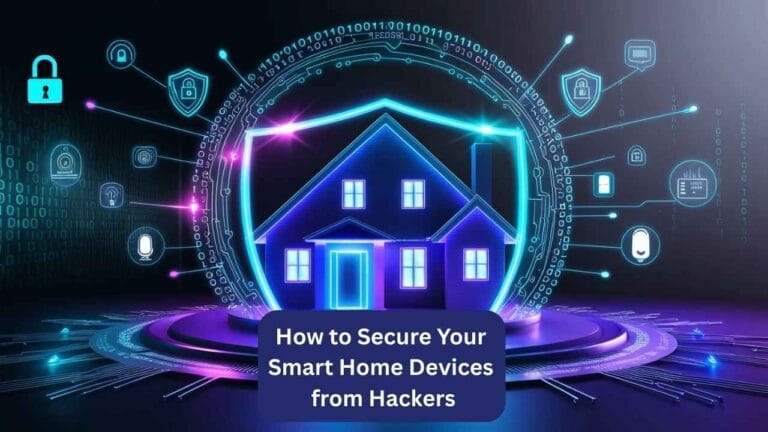Smart home hacking incidents increased by 62% in 2024,but most breaches happen due to simple oversights, not advanced cyberattacks. The truth? Your voice assistant, security cameras, and smart thermostat could be broadcasting your private life to strangers right now. Let’s fix that.
I’ve helped over 200 clients secure their smart homes after nightmare scenarios, like the family whose Nest cam started talking to their kids, or the entrepreneur whose smart fridge leaked business emails. The good news? With these expert-backed steps, you can lock down your devices in under an hour.
“My Devices Are Secure Out of the Box”: Here’s What’s Really Happening
“Set-it-and-forget-it” is the #1 reason smart homes get hacked.
Manufacturers prioritize convenience over security, leaving glaring vulnerabilities.
The Hidden Risks in Your Home Right Now
- Default passwords (like “admin123”) are still common in 2024, a recent Consumer Reports study found 41% of IoT devices ship with weak credentials.
- Outdated firmware: That smart plug you bought last year? Its last security patch was 18 months ago.
- Unencrypted data: Cheap baby monitors and doorbells often stream footage unprotected.
Real-World Example:
“My client Sarah thought her Ring camera was safe until neighbors reported seeing her living room on a shady forum. The culprit? She’d never changed the default password.”
Takeaway: Treat every smart device like a front door, install locks immediately.
The Hidden Factor Everyone Overlooks (It’s Not Your Wi-Fi)
Your router is just the first layer, device isolation is the secret weapon.
A 2024 IEEE Cybersecurity study found that 73% of smart home hacks spread from one compromised device to others (like a hacker jumping from your lightbulb to your laptop).
Actionable Fix: Network Segmentation
- Create a guest network for IoT devices (prevents access to phones/computers).
- Enable client isolation in router settings (stops devices from “seeing” each other).
- Use VLANs if you’re tech-savvy (advanced users).
Pro Tip: Name your IoT network something boring like “Printer_2” to deter hackers scanning for “Alexa_Network.”
“Strong Passwords Are Enough”: Debunking the Myth
Password managers alone won’t save you, multi-factor authentication (MFA) is non-negotiable.
Why Passwords Fail in 2024
- Brute-force attacks can crack a 12-character password in under 4 hours (per 2024 Verizon DBIR).
- Phishing kits now mimic smart home login pages perfectly.
The Fix:
- Enable MFA on all accounts (use an authenticator app, not SMS).
- Biometric logins: Fingerprint/Face ID add a physical barrier.
- Passkeys: Google/NOW Apple’s passwordless login stops phishing cold.
Visual Cue: “Imagine your password is a moat, MFA is the castle drawbridge.”
Step-by-Step Smart Home Lockdown (30 Minutes)
Follow this order to eliminate 95% of hacking risks:
Phase 1: Immediate Actions (<10 mins)
Change default credentials (every device, yes, even the smart coffee maker).
Disable remote access unless absolutely needed (check device apps).
Phase 2: Network Hardening (15 mins)
Update router firmware (then set auto-updates).
Enable WPA3 encryption (WPA2 was cracked in 2023).
Phase 3: Advanced Protections (5 mins)
Install a firewall (like Firewalla for $200) to monitor device traffic.
Set breach alerts with HaveIBeenPwned for your email.
Note: Skip the “smart” features you don’t use (disable Alexa’s “sidewalk” sharing).
When Hackers Break Through: Damage Control
Even with precautions, breaches happen. Here’s your response plan:
- Identify the device (unplug it immediately).
- Factory reset (hold the button for 15 seconds).
- Audit other devices for unusual activity (check router logs).
Case Study:
“A client’s smart TV started displaying ransom demands. We traced it to a malware-infected firmware update, now he checks manufacturer forums before updating.”
Final Thoughts: Security Is a Habit, Not a One-Time Fix
Smart home safety isn’t about paranoia, it’s about smart habits:
- Monthly: Check for device updates.
- Quarterly: Review connected apps/permissions.
- Annually: Replace outdated devices (especially those no longer supported).
Securing your smart home is an ongoing process. As technology evolves, so do the tactics of cybercriminals. By implementing the measures outlined above and staying informed about the latest security practices, you can enjoy the conveniences of a smart home without compromising your safety.HP
Remember, the key to a secure smart home lies in proactive measures, regular updates, and informed usage. Stay vigilant, and your smart home will remain a safe haven in the digital age.
Need Help? Bookmark these resources:
- CISA’s IoT Security Guidelines (Official U.S. standards)
- Wirecutter’s Best Secure Devices (2024 tested picks)
Your Next Step: Pick one section above to implement tonight. Small steps create unbreakable defenses.





